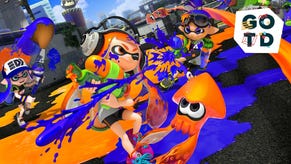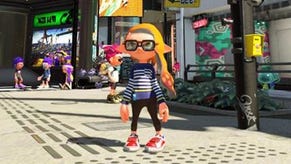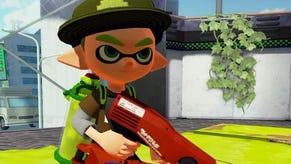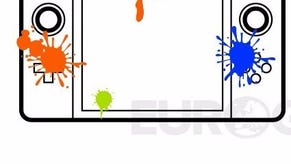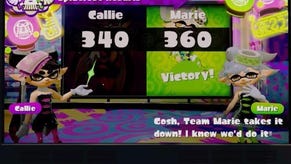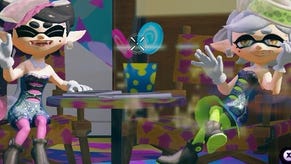How Nintendo is reinventing the shooter with Splatoon
Squid's in.
Who would have thought the best third-person shooter to emerge at last week's E3 would come from Nintendo? The reveal of Splatoon, a colourful squad-based shooter, was typical of a company that managed to hit all the right beats in Los Angeles, delivering something far more significant than a new Mario, or a new Metroid - it was an all-new IP, produced by the next generation of talent within Nintendo that's all-important to its future.
There's a guiding hand too, of course, and as I'm ushered in to meet Splatoon's producer, Hisashi Nogami, and one of its directors, Tsubasa Sakaguchi, in the corner sits Katsuya Eguchi, a veteran of Nintendo's second Entertainment Analysis and Development group whose career stretches back to Super Mario Bros. 3. He jabs away at a laptop, occasionally chuckling to himself at his young team's responses to questions, occasionally prodding them towards certain answers before returning to his work.
It's not as if Splatoon's team are new to Nintendo - producer Nogami boasts 20 years' experience working at EAD, having started as an artist drawing backgrounds on Yoshi's Island before moving on to the Animal Crossing series. Director Sakaguchi, meanwhile, has a full decade under his belt, his career commencing with character design on The Legend of Zelda: Twilight Princess before most recently working as an artist on NintendoLand.
What they are doing, though, is bringing new ideas to a Nintendo that in recent years has been leaning too heavily on its established hits. Not only that, it's uncharted territory for Nintendo: an entry into the gruff, tough world of multiplayer arena games that takes a lateral perspective on them, through a rainbow brightly, making for perhaps the freshest spin on the genre since Team Fortress 2.
Splatoon began life as one of many prototypes within the halls of Nintendo's EAD, an idea brought to life by a single programmer - Shintaro Sato - who had been tasked with coming up with something new. "It's something we do a lot of at EAD," explains Nogami, perched keenly on the edge of a clean white sofa as he speaks. "We're constantly making different prototypes with different game ideas to see what's going to be good. One prototype that a programmer made was just this kind of idea of shooting ink on the ground, and doing a territory control game. We played it, thought it was really fun and maybe we can make a full game out of this."
The transition from prototype to full project came via a presentation to Nogami's management - Eguchi looks up from his laptop and exchanges a playful look with his team, quietly confessing he was part of that group - and the commencement of a long, drawn-out period of development and refinement. But what was the initial reaction upon presenting Splatoon?
"The reaction was good!" says Nogami. "We got called back to keep refining things, and we presented it multiple times before we got to where we are now." The basic premise remains: playing in one of two teams of four, your task is simply to paint as much of the map as possible in your team's corresponding colour - and so, in a genius inversion, it's a shooter in which you never have to shoot anyone, a MOBA in which you're encouraged to laugh, not shout.
"In the beginning, it was a white box that you could move this way and that and shoot ink in. It was very, very simple," says Nogami. "We found that when people were playing it some people would rush to the front and engage the enemy, and some people might hang back and try and paint their base more. Even then, in that prototype, there were lots of play-styles coming about. So we thought this could be a game that lots of people could enjoy and play at the same time. It was interesting even then, but we knew that we had to give it a more Nintendo feel, and have more Nintendo-like actions - so we had more raised platforms, the ability to swim quicker, to be able to look around more easily and readily."
It's that Nintendo feel, and how it's layered on, that's the interesting part - it's where the dark art that powers Nintendo's bright magic lies, and it's where Splatoon becomes more than a cute curiosity. The details are delightful, starting from the very feel of the characters, conducted by moving the GamePad to aim and shoot while using the analogue stick for movement, to the player's sleek transformation into a squid as they dive into their own ink, a form that allows for swift movement as well as stealth. It's a step away from traditional third-person controls, and one that may well initially frustrate, but it's integral to the feel of Splatoon. "If we didn't have the GamePad, we wouldn't be able to create the game we have now," explains Nogami.

"The GamePad was in there from the beginning. We obviously went through a lot of tuning processes to get it where it is now. We had to think about lots of different things - what buttons should go where, what buttons should do what, how sensitive the gyro should be. You might not be super aware when you play the game, but we did a lot of testing to make sure the game feels as good as it does now."
Splatoon is at the forefront of Nintendo's rediscovery of the Wii U's GamePad, following a year in which it's been largely ignored by first-party games. Elsewhere on the show floor at E3, Miyamoto's own experiments show a more piecemeal approach, but Splatoon has built an entire game around the GamePad, its motion control and the space between the screens. A map on the GamePad shows your progress and the whereabouts of your team-mates, while when playing as a squid you're able to leap to their side simply by pressing their icon on the touchscreen.
"It wasn't exactly that creating this game was necessarily part of an overall movement to make more games that use the GamePad, but in the process of creating this game, using the GamePad felt like a very natural thing to do," says Nogami. "Even from the time of the prototype, being able to use two screens was absolutely necessary. Being able to at any instance see what's around you, but also the overall situation, that was absolutely necessary."
Sakaguchi, who up until this point has been silently, thoughtfully observing our interview, suddenly becomes animated. "The motion controls are very important! The ability to touch, and the super-jump - in order to make all that possible, you have to have the entire map displayed. That's because, one interesting part of this game, you have to be able to see how the ink is being spread out, and use that information to decide where you're going to go. They have to constantly make these decisions instantly. So if you want to build the game around having players making those decisions, you need to have the display there but also, through a very simple input, make that kind of decision. That's why we're using the GamePad as much as we are."
Sakaguchi is a man obsessed over the details, it seems - he's particularly proud of the sound the squid makes as it dives into the ink, the result of hitting slime again and again in the office until the team came across the right result - and it shows in the simple, joyous act of painting Splatoon's scenery.
"That whole action of spraying that ink, it's kind of an action, but it's also a way to make a decision," he says. "We kind of think of the TV being where the action happens, and the GamePad screen is where you make your decisions - what links that together is the action of painting the ink."
Splatoon is a messy game, then, built around the simple pleasure of slinging paint across the scenery, but as you'd expect from Nintendo it's a tightly choreographed, finely crafted brand of anarchy. Miyamoto's had a hand in directing that anarchy, pushing the young team towards a more defined mess. "He's definitely someone who's very strict when it comes to making things," says Nogami. "He'll come in and say, 'Is this really okay like this? Can you make it more fun?'

"One thing is the fact that as the characters are playing they'll get more and more covered in ink. Mr. Miyamoto wanted to make it more obvious, and more easy to see they were getting covered in ink. That's the kind of detail he gets very, very focussed on. He gets very particular about making it feel like you've had an experience - if you were painting something, you are going to get covered in paint. So in Splatoon you should have that same feeling - it makes the characters feel more sympathetic. The basic gameplay of spraying this ink around - it's kind of like vandals throwing tomatoes around. And if in the course of that you get some paint on yourself, you kind of feel you're going to let go and get involved yourself. It makes it more exciting."
What's really exciting, though, is seeing Nintendo discover worlds that it was previously closed off to - and how it's reinventing genres that have long become stale in the west. As ever, it's in the details, and how they all come together: how the paint splashes across surfaces, how your arsenal comprises of paint guns and rollers, and how grenades have been fine-tuned to a tee.
"The time it takes a bomb to explode and how fast players can move - they are very much related," says Sakaguchi. "We want to make it so it's the perfect amount of time to just be able to get away. So if you have a bomb that comes on the edge of the screen and you notice it, you'll just be able to get away. We don't want to make it so you'll definitely die, or you'll definitely get away, but it'll always be close. The other things - that's all the kind of know-how we have from the years of making games at EAD.
"Sometimes, with the game design, we think about all these elements one at a time very, very seriously - that hasn't changed. And then the arc the shots make - that's not actually following real physics. We think about how long it should take, and what's the right amount of time it should take for it to feel good. That also involves the way the map is set up, and in terms of how long it takes to move and aim. All of that is connected, and we have to think about it all at the same time."
As is so often the case within Nintendo, Splatoon is an example of how countless little details are polished to perfection. It's about how one simple whole is the result of countless years of experience and hours of graft and thought that whir away just beneath the surface.
As our time draws to a close, Nogami smiles graciously when I thank him for all the hard work that goes on behind the scenes at Nintendo EAD. "Our job," he says, "is to make it so you never know."



